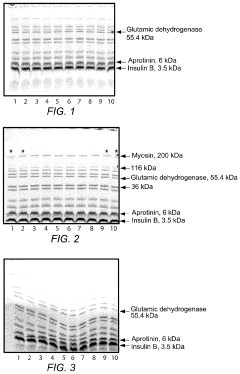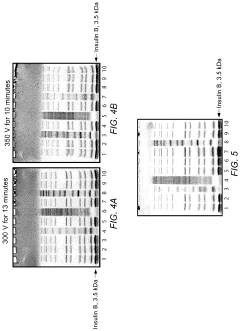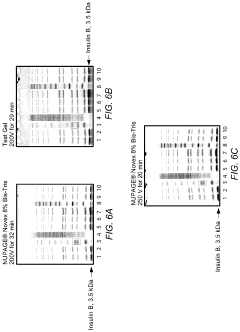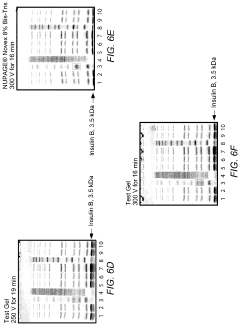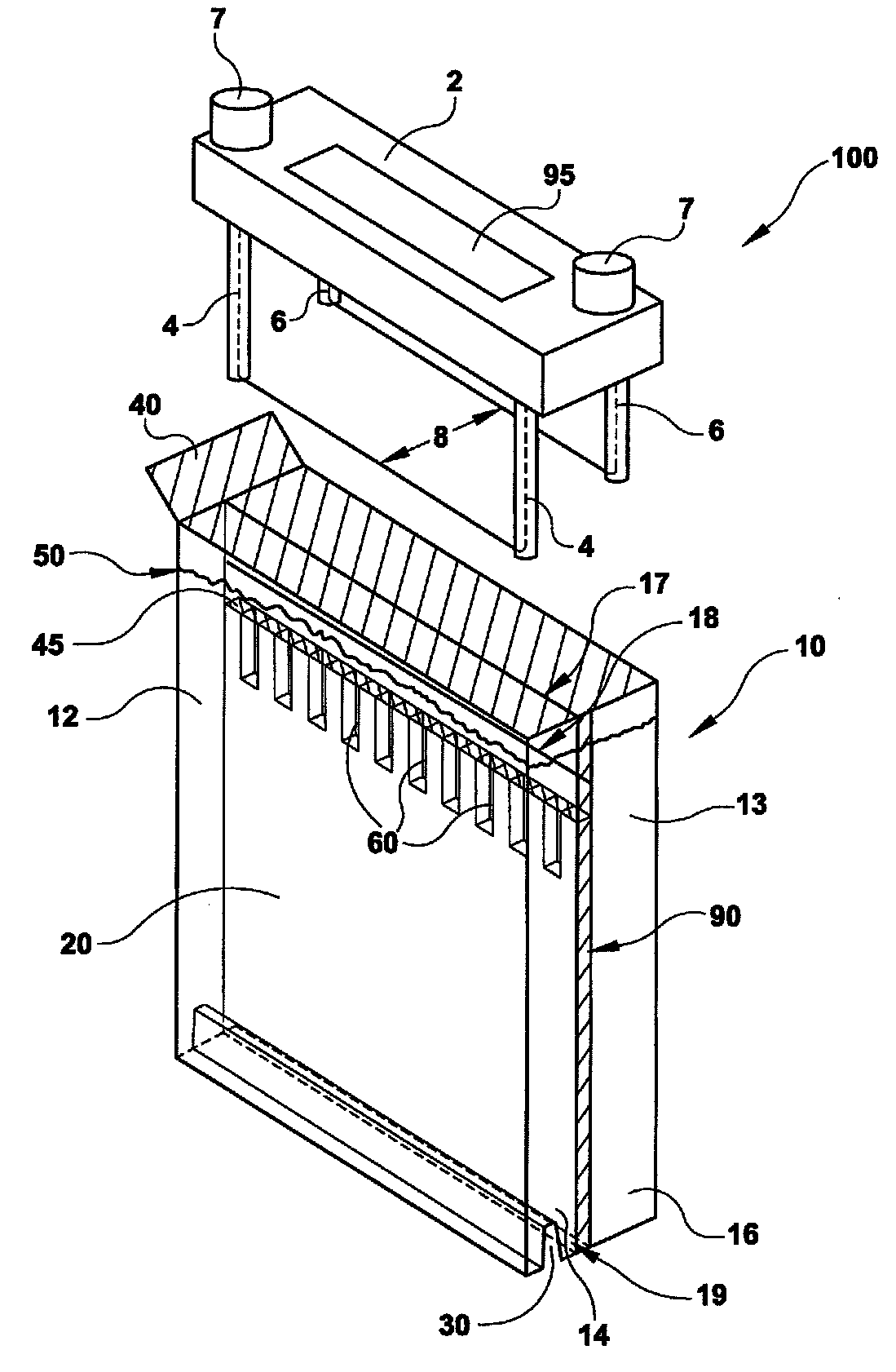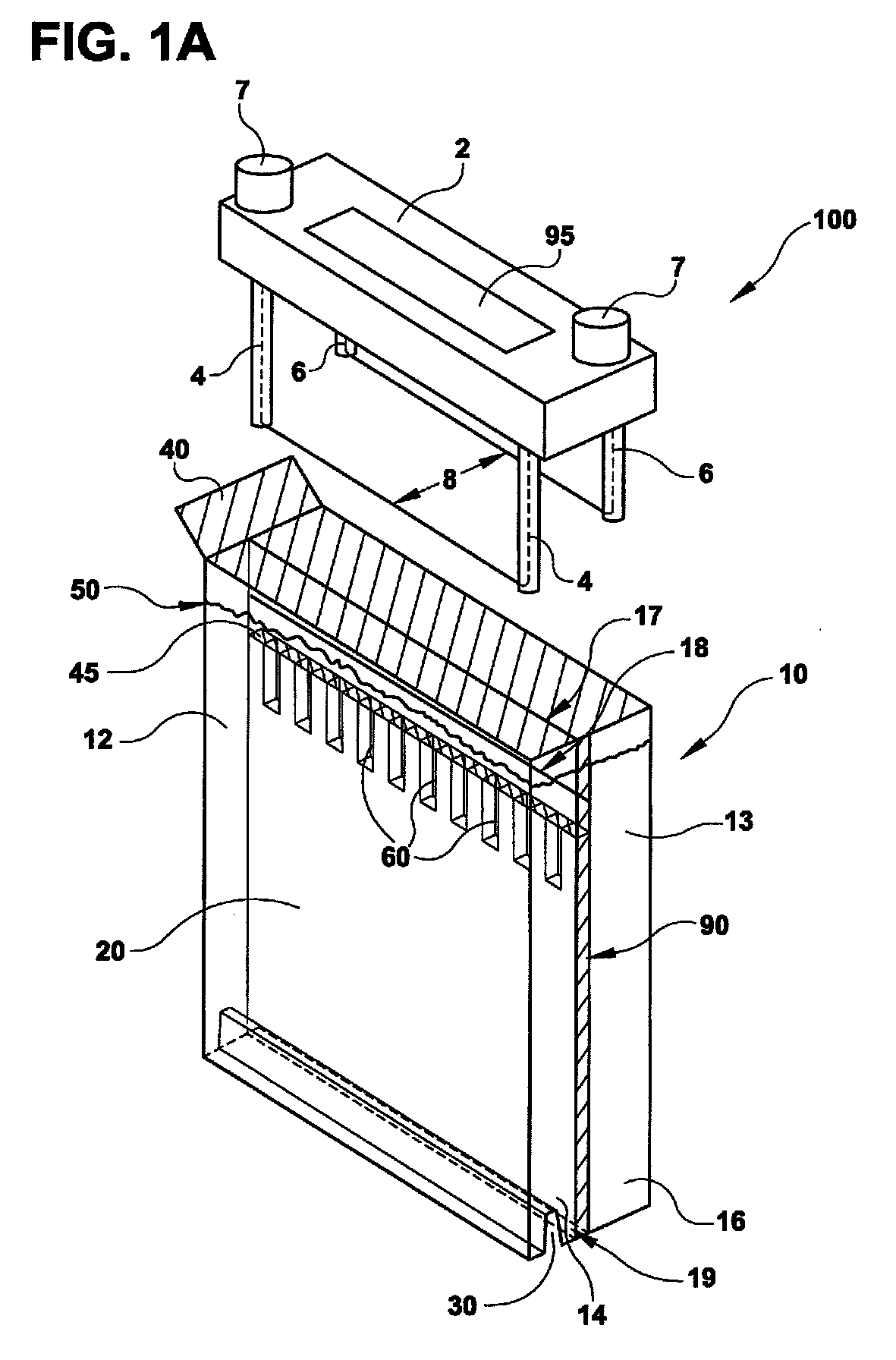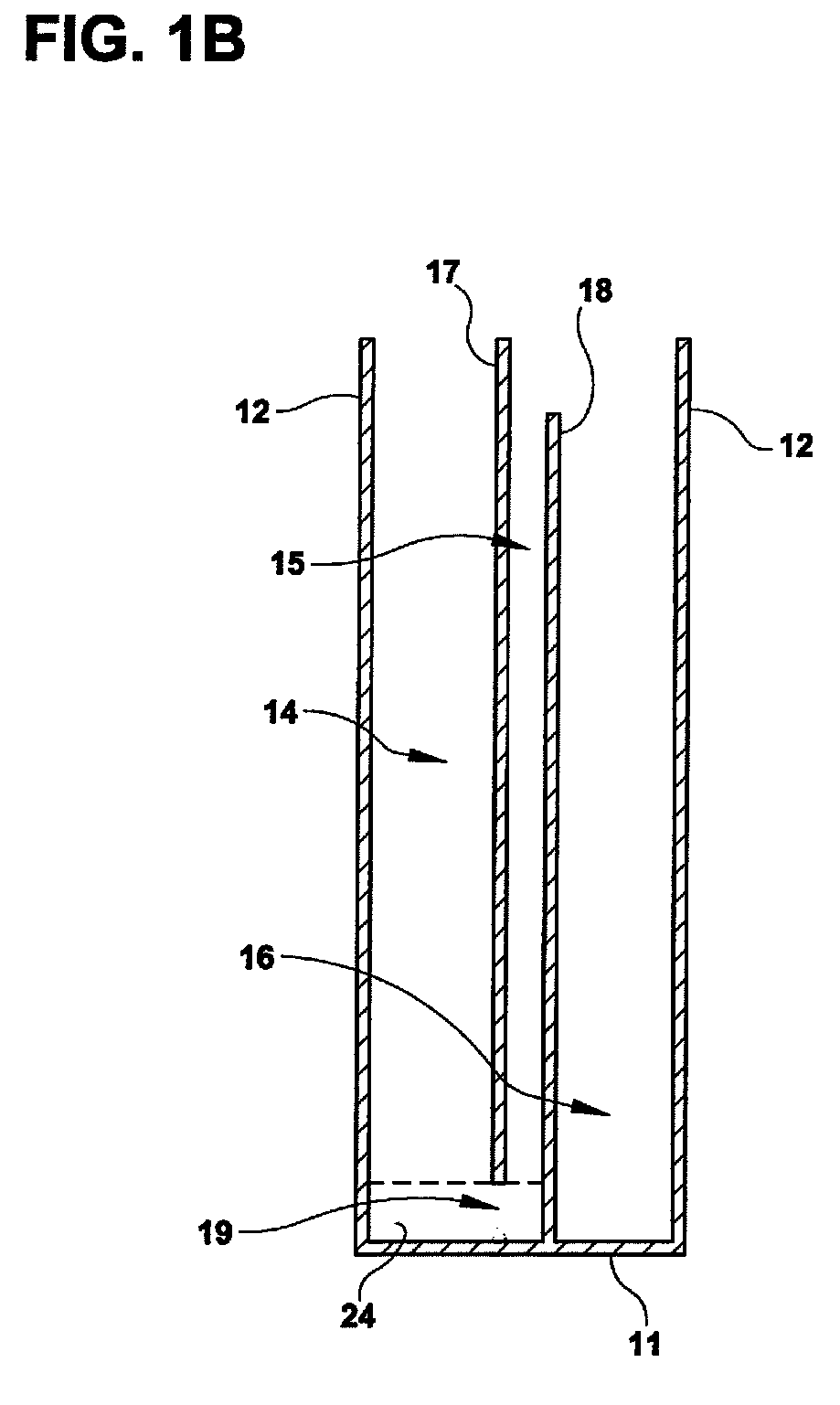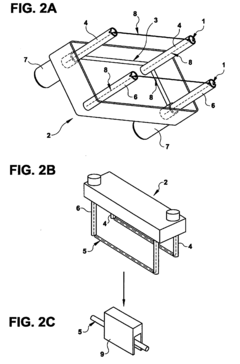How to Conduct Reliable Gel Electrophoresis in the Lab?
JUN 30, 20259 MIN READ
Generate Your Research Report Instantly with AI Agent
Patsnap Eureka helps you evaluate technical feasibility & market potential.
Gel Electrophoresis Background and Objectives
Gel electrophoresis is a fundamental technique in molecular biology, widely used for separating and analyzing DNA, RNA, and proteins. This method has evolved significantly since its inception in the 1960s, becoming an indispensable tool in various fields, including genetics, forensics, and medical diagnostics. The technique's core principle relies on the migration of charged molecules through a gel matrix under an electric field, with smaller molecules moving faster than larger ones.
The development of gel electrophoresis has been marked by continuous improvements in resolution, speed, and reproducibility. Early methods used starch gels, which were later replaced by agarose and polyacrylamide gels, offering better separation and visualization of biomolecules. The introduction of pulsed-field gel electrophoresis in the 1980s further expanded the technique's capabilities, allowing for the separation of much larger DNA fragments.
Recent technological advancements have focused on enhancing the reliability and efficiency of gel electrophoresis. These include the development of pre-cast gels, automated electrophoresis systems, and high-sensitivity staining methods. Such innovations have significantly reduced the time and skill required to perform the technique while improving result consistency.
The primary objective of conducting reliable gel electrophoresis in the laboratory is to achieve accurate, reproducible, and high-resolution separation of biomolecules. This involves optimizing various parameters such as gel concentration, buffer composition, voltage, and run time. Additionally, researchers aim to minimize common issues like smearing, band distortion, and uneven migration, which can compromise result interpretation.
Another crucial goal is to enhance the technique's sensitivity, enabling the detection of low-abundance molecules. This is particularly important in applications such as gene expression analysis and protein quantification. Researchers are also focusing on developing more environmentally friendly and safer alternatives to traditional staining methods, which often involve hazardous chemicals.
As gel electrophoresis continues to evolve, there is a growing emphasis on integrating it with other analytical techniques. This includes coupling electrophoresis with mass spectrometry or combining it with microfluidic devices for lab-on-a-chip applications. Such integrations aim to provide more comprehensive and rapid analysis of complex biological samples.
In conclusion, the background and objectives of gel electrophoresis reflect its critical role in molecular biology and its ongoing evolution. The technique's development trajectory is driven by the need for increased reliability, efficiency, and versatility in biomolecule analysis, paving the way for new discoveries and applications in life sciences research.
The development of gel electrophoresis has been marked by continuous improvements in resolution, speed, and reproducibility. Early methods used starch gels, which were later replaced by agarose and polyacrylamide gels, offering better separation and visualization of biomolecules. The introduction of pulsed-field gel electrophoresis in the 1980s further expanded the technique's capabilities, allowing for the separation of much larger DNA fragments.
Recent technological advancements have focused on enhancing the reliability and efficiency of gel electrophoresis. These include the development of pre-cast gels, automated electrophoresis systems, and high-sensitivity staining methods. Such innovations have significantly reduced the time and skill required to perform the technique while improving result consistency.
The primary objective of conducting reliable gel electrophoresis in the laboratory is to achieve accurate, reproducible, and high-resolution separation of biomolecules. This involves optimizing various parameters such as gel concentration, buffer composition, voltage, and run time. Additionally, researchers aim to minimize common issues like smearing, band distortion, and uneven migration, which can compromise result interpretation.
Another crucial goal is to enhance the technique's sensitivity, enabling the detection of low-abundance molecules. This is particularly important in applications such as gene expression analysis and protein quantification. Researchers are also focusing on developing more environmentally friendly and safer alternatives to traditional staining methods, which often involve hazardous chemicals.
As gel electrophoresis continues to evolve, there is a growing emphasis on integrating it with other analytical techniques. This includes coupling electrophoresis with mass spectrometry or combining it with microfluidic devices for lab-on-a-chip applications. Such integrations aim to provide more comprehensive and rapid analysis of complex biological samples.
In conclusion, the background and objectives of gel electrophoresis reflect its critical role in molecular biology and its ongoing evolution. The technique's development trajectory is driven by the need for increased reliability, efficiency, and versatility in biomolecule analysis, paving the way for new discoveries and applications in life sciences research.
Applications in Molecular Biology Research
Gel electrophoresis has become an indispensable technique in molecular biology research, offering a wide range of applications that have revolutionized our understanding of genetic material and protein structures. This method's versatility and reliability have made it a cornerstone in numerous fields of biological investigation.
One of the primary applications of gel electrophoresis in molecular biology is DNA fragment analysis. Researchers use this technique to separate and visualize DNA fragments of different sizes, which is crucial in various genetic studies. For instance, in restriction fragment length polymorphism (RFLP) analysis, gel electrophoresis allows scientists to identify genetic variations between individuals or species by comparing the patterns of DNA fragments produced by specific restriction enzymes.
In polymerase chain reaction (PCR) experiments, gel electrophoresis serves as a vital tool for verifying the success of DNA amplification and assessing the size of the amplified products. This application is particularly important in diagnostic molecular biology, where specific DNA sequences are amplified to detect the presence of pathogens or genetic mutations associated with diseases.
Gel electrophoresis also plays a significant role in DNA sequencing projects. In the Sanger sequencing method, DNA fragments terminated at different nucleotides are separated on a gel, allowing researchers to determine the sequence of bases in a DNA molecule. Although modern sequencing technologies have largely replaced this approach, gel electrophoresis remains relevant in quality control and validation of sequencing results.
In the field of protein research, gel electrophoresis, particularly sodium dodecyl sulfate-polyacrylamide gel electrophoresis (SDS-PAGE), is extensively used to separate and analyze proteins based on their molecular weight. This technique is crucial for studying protein expression patterns, identifying protein-protein interactions, and characterizing protein complexes. Two-dimensional gel electrophoresis further enhances protein separation by combining isoelectric focusing with SDS-PAGE, allowing researchers to resolve complex protein mixtures and study post-translational modifications.
Gel electrophoresis is also an essential tool in molecular cloning experiments. It is used to verify the success of DNA ligation reactions, screen for recombinant plasmids, and confirm the presence and orientation of inserted DNA fragments. This application is fundamental in genetic engineering and the production of recombinant proteins for biotechnological and pharmaceutical purposes.
In forensic science, gel electrophoresis is employed in DNA profiling techniques such as restriction fragment length polymorphism (RFLP) analysis and short tandem repeat (STR) analysis. These methods have revolutionized criminal investigations and paternity testing by providing a reliable means of identifying individuals based on their unique genetic profiles.
One of the primary applications of gel electrophoresis in molecular biology is DNA fragment analysis. Researchers use this technique to separate and visualize DNA fragments of different sizes, which is crucial in various genetic studies. For instance, in restriction fragment length polymorphism (RFLP) analysis, gel electrophoresis allows scientists to identify genetic variations between individuals or species by comparing the patterns of DNA fragments produced by specific restriction enzymes.
In polymerase chain reaction (PCR) experiments, gel electrophoresis serves as a vital tool for verifying the success of DNA amplification and assessing the size of the amplified products. This application is particularly important in diagnostic molecular biology, where specific DNA sequences are amplified to detect the presence of pathogens or genetic mutations associated with diseases.
Gel electrophoresis also plays a significant role in DNA sequencing projects. In the Sanger sequencing method, DNA fragments terminated at different nucleotides are separated on a gel, allowing researchers to determine the sequence of bases in a DNA molecule. Although modern sequencing technologies have largely replaced this approach, gel electrophoresis remains relevant in quality control and validation of sequencing results.
In the field of protein research, gel electrophoresis, particularly sodium dodecyl sulfate-polyacrylamide gel electrophoresis (SDS-PAGE), is extensively used to separate and analyze proteins based on their molecular weight. This technique is crucial for studying protein expression patterns, identifying protein-protein interactions, and characterizing protein complexes. Two-dimensional gel electrophoresis further enhances protein separation by combining isoelectric focusing with SDS-PAGE, allowing researchers to resolve complex protein mixtures and study post-translational modifications.
Gel electrophoresis is also an essential tool in molecular cloning experiments. It is used to verify the success of DNA ligation reactions, screen for recombinant plasmids, and confirm the presence and orientation of inserted DNA fragments. This application is fundamental in genetic engineering and the production of recombinant proteins for biotechnological and pharmaceutical purposes.
In forensic science, gel electrophoresis is employed in DNA profiling techniques such as restriction fragment length polymorphism (RFLP) analysis and short tandem repeat (STR) analysis. These methods have revolutionized criminal investigations and paternity testing by providing a reliable means of identifying individuals based on their unique genetic profiles.
Current Challenges in Gel Electrophoresis
Gel electrophoresis remains a fundamental technique in molecular biology, yet it faces several challenges that can impact its reliability and reproducibility. One of the primary issues is inconsistent gel preparation, which can lead to uneven migration of molecules and distorted results. Variations in gel concentration, polymerization time, and buffer composition can significantly affect the separation of DNA or protein samples.
Another challenge is the occurrence of band distortions, often caused by overloading of samples or the presence of contaminants. These distortions can make it difficult to accurately interpret results, especially when precise size determination is crucial. Additionally, the formation of air bubbles during gel casting or sample loading can create artifacts that interfere with band visualization and analysis.
Temperature fluctuations during electrophoresis pose a significant problem, as they can cause band smearing and affect the overall resolution of the separation. Maintaining a consistent temperature throughout the run is essential for obtaining reliable results, particularly for longer electrophoresis times or when working with temperature-sensitive samples.
The choice of staining method and its execution also present challenges. Overstaining or understaining can lead to difficulties in band detection and quantification. Moreover, some staining techniques may introduce background noise or interfere with downstream applications, limiting the usefulness of the separated molecules for further analysis.
Reproducibility across different laboratories or even within the same lab over time is a persistent issue in gel electrophoresis. Variations in equipment, reagents, and environmental conditions can lead to inconsistent results, making it challenging to compare data from different experiments or research groups.
Lastly, the limited resolution of traditional gel electrophoresis techniques, especially for larger molecules or complex mixtures, remains a significant challenge. This limitation can hinder the accurate separation and identification of closely related species or low-abundance molecules in complex samples.
Addressing these challenges requires a combination of standardized protocols, quality control measures, and the development of new technologies to enhance the reliability and reproducibility of gel electrophoresis in laboratory settings.
Another challenge is the occurrence of band distortions, often caused by overloading of samples or the presence of contaminants. These distortions can make it difficult to accurately interpret results, especially when precise size determination is crucial. Additionally, the formation of air bubbles during gel casting or sample loading can create artifacts that interfere with band visualization and analysis.
Temperature fluctuations during electrophoresis pose a significant problem, as they can cause band smearing and affect the overall resolution of the separation. Maintaining a consistent temperature throughout the run is essential for obtaining reliable results, particularly for longer electrophoresis times or when working with temperature-sensitive samples.
The choice of staining method and its execution also present challenges. Overstaining or understaining can lead to difficulties in band detection and quantification. Moreover, some staining techniques may introduce background noise or interfere with downstream applications, limiting the usefulness of the separated molecules for further analysis.
Reproducibility across different laboratories or even within the same lab over time is a persistent issue in gel electrophoresis. Variations in equipment, reagents, and environmental conditions can lead to inconsistent results, making it challenging to compare data from different experiments or research groups.
Lastly, the limited resolution of traditional gel electrophoresis techniques, especially for larger molecules or complex mixtures, remains a significant challenge. This limitation can hinder the accurate separation and identification of closely related species or low-abundance molecules in complex samples.
Addressing these challenges requires a combination of standardized protocols, quality control measures, and the development of new technologies to enhance the reliability and reproducibility of gel electrophoresis in laboratory settings.
Standard Protocols for Gel Electrophoresis
01 Improved gel composition for electrophoresis
Enhanced gel compositions are developed to improve the reliability of gel electrophoresis. These compositions may include specific polymers, cross-linking agents, or additives that enhance separation efficiency, reduce background noise, and improve overall resolution. Such improvements in gel composition contribute to more consistent and reliable results in electrophoretic analyses.- Improved gel composition for electrophoresis: Enhanced gel compositions are developed to improve the reliability of gel electrophoresis. These compositions may include specific polymers, cross-linking agents, or additives that enhance separation efficiency, reduce background noise, and improve overall resolution. Such improvements in gel composition contribute to more consistent and reliable results in electrophoretic analyses.
- Advanced detection and quantification methods: Innovative detection and quantification techniques are implemented to enhance the reliability of gel electrophoresis results. These may include fluorescent labeling, chemiluminescence, or advanced imaging systems that improve sensitivity and accuracy in detecting and measuring separated molecules. Such methods contribute to more reliable data interpretation and analysis.
- Automated gel electrophoresis systems: Automated systems for gel electrophoresis are developed to minimize human error and increase reproducibility. These systems may include automated sample loading, running conditions control, and result analysis. By reducing manual intervention, these automated systems contribute to improved reliability and consistency in gel electrophoresis experiments.
- Standardization of protocols and quality control: Standardized protocols and quality control measures are implemented to ensure consistent and reliable results in gel electrophoresis. This includes the development of reference standards, internal controls, and calibration methods. Such standardization efforts help to minimize variability between experiments and laboratories, enhancing the overall reliability of gel electrophoresis techniques.
- Novel electrode and buffer systems: Innovative electrode designs and buffer systems are developed to improve the reliability of gel electrophoresis. These advancements may include specialized electrode materials, buffer compositions, or electrophoresis cell designs that enhance separation efficiency and reduce artifacts. Such improvements in the electrophoresis setup contribute to more reliable and reproducible results.
02 Advanced detection and quantification methods
Innovative detection and quantification techniques are implemented to enhance the reliability of gel electrophoresis results. These may include fluorescent labeling, chemiluminescence, or advanced imaging systems that improve sensitivity and accuracy in detecting and measuring separated molecules. Such methods contribute to more reliable data interpretation and analysis.Expand Specific Solutions03 Automated gel electrophoresis systems
Automated systems are developed to standardize and improve the reliability of gel electrophoresis procedures. These systems may include automated sample loading, running conditions control, and result analysis, reducing human error and increasing reproducibility. Automation contributes to more consistent and reliable results across different experiments and laboratories.Expand Specific Solutions04 Quality control and standardization measures
Implementation of quality control measures and standardization protocols to enhance the reliability of gel electrophoresis. This may include the use of internal standards, reference markers, or calibration methods to ensure consistent performance and accurate interpretation of results. Such measures help in minimizing variability and improving the overall reliability of the technique.Expand Specific Solutions05 Novel electrode and buffer systems
Development of innovative electrode designs and buffer compositions to improve the reliability and efficiency of gel electrophoresis. These advancements may include specialized electrode materials, buffer formulations, or electrophoresis chamber designs that enhance separation quality, reduce artifacts, and improve overall reliability of the technique.Expand Specific Solutions
Key Manufacturers of Electrophoresis Equipment
The gel electrophoresis market is in a mature stage, with a global size estimated at over $1 billion. The technology is well-established and widely used in molecular biology research and clinical diagnostics. Key players like Life Technologies, Bio-Rad Laboratories, and Applied Biosystems dominate the market with advanced systems and consumables. Emerging companies such as Sage Science and Expedeon are introducing innovative products to enhance separation efficiency and automation. Academic institutions like Oregon Health & Science University and Jilin University contribute to ongoing research and development in this field. The market is characterized by incremental innovations in gel formulations, imaging systems, and data analysis software to improve resolution and reproducibility of results.
Life Technologies Corp.
Technical Solution: Life Technologies, now part of Thermo Fisher Scientific, has developed the E-Gel electrophoresis system, which uses pre-cast agarose gels with integrated electrodes. This technology eliminates the need for traditional gel preparation and buffer systems, significantly reducing hands-on time [11]. The E-Gel system includes a range of gel percentages and well formats to accommodate various sample types and sizes. Life Technologies has also introduced the E-Gel Power Snap Electrophoresis Device, which features real-time LED visualization of DNA migration during the run [12]. Their latest innovations include the E-Gel NGS system, optimized for size selection in next-generation sequencing library preparation workflows.
Strengths: Rapid and convenient gel electrophoresis with minimal setup, consistent gel quality, and integration with molecular biology workflows. Weaknesses: Limited to specific gel formats, may have higher per-gel costs compared to traditional methods.
Cytiva Sweden AB
Technical Solution: Cytiva (formerly GE Healthcare Life Sciences) has developed the Amersham ECL Gel system, which provides high-resolution protein separation with minimal sample preparation. Their technology includes a unique gel matrix that allows for faster run times and sharper band resolution [4]. Cytiva's system also incorporates a buffer formulation that maintains pH stability during long runs, ensuring consistent results. They have introduced automated gel casting systems that produce gels with highly uniform pore sizes, reducing gel-to-gel variability [5]. Cytiva's imaging solutions use advanced CCD technology for sensitive detection of fluorescent and chemiluminescent signals from gels and blots [6].
Strengths: High-throughput capabilities, excellent reproducibility, and integration with downstream applications like Western blotting. Weaknesses: Specialized consumables may be required, potentially higher initial investment for complete system setup.
Innovations in Gel Matrix and Buffer Solutions
System for rapid high-resolution GEL electrophoresis
PatentActiveUS20190391113A1
Innovation
- The development of electrophoretic systems and formulations that allow for higher field strengths up to 50% more than conventional systems, using a discontinuous buffer system with specific gel amine and ampholyte buffers, and a pH range of 5.5 to 7.5, enabling faster separation of proteins within 30 minutes or less, even at higher voltages.
Monolithic electrophoresis gel system
PatentInactiveUS20100326830A1
Innovation
- A prefabricated, monolithic gel electrophoresis apparatus that integrates a pre-cast gel matrix and buffer chambers into a single, molded unit, eliminating the need for assembly and minimizing handling and preparation, with a reusable lid for electrical connection and buffer management.
Safety Considerations in Electrophoresis Labs
Safety considerations are paramount in electrophoresis labs to ensure the well-being of researchers and the integrity of experiments. The primary hazards associated with gel electrophoresis include electrical risks, chemical exposure, and potential biological contamination. To mitigate these risks, laboratories must implement comprehensive safety protocols and provide adequate training to all personnel.
Electrical safety is a critical concern in electrophoresis labs due to the use of high-voltage power supplies. All electrical equipment should be regularly inspected and maintained to prevent malfunctions. Researchers must be trained to handle power supplies safely, ensuring proper grounding and avoiding contact with live electrical components. It is essential to keep the electrophoresis apparatus away from water sources and to never operate it with wet hands or in damp conditions.
Chemical safety is another crucial aspect of electrophoresis lab safety. Many of the reagents used in gel preparation and staining are hazardous, including acrylamide, which is a neurotoxin and potential carcinogen. Proper personal protective equipment (PPE) such as gloves, lab coats, and safety goggles must be worn at all times when handling these chemicals. Adequate ventilation is necessary to minimize exposure to fumes, particularly when working with ethidium bromide, a common DNA stain that is mutagenic.
Proper disposal of electrophoresis materials is essential to prevent environmental contamination. Used gels, buffers, and other chemical waste must be collected and disposed of according to institutional and regulatory guidelines. Sharps, such as broken glass or contaminated pipette tips, should be disposed of in designated sharps containers to prevent injuries and potential biological exposure.
Biological safety measures are crucial when working with potentially infectious samples. All biological materials should be treated as if they are infectious, and appropriate containment measures should be in place. This includes the use of biosafety cabinets when necessary and proper decontamination procedures for all equipment and work surfaces.
Emergency preparedness is an integral part of lab safety. Electrophoresis labs should be equipped with easily accessible eyewash stations, safety showers, and fire extinguishers. Clear protocols for handling spills, electrical accidents, and other emergencies should be established and regularly reviewed with all lab personnel.
Training and education are fundamental to maintaining a safe electrophoresis lab environment. All researchers should receive comprehensive safety training before beginning work, including instruction on proper equipment use, chemical handling, waste disposal, and emergency procedures. Regular safety refresher courses and updates on new safety protocols should be provided to ensure ongoing compliance and awareness.
Electrical safety is a critical concern in electrophoresis labs due to the use of high-voltage power supplies. All electrical equipment should be regularly inspected and maintained to prevent malfunctions. Researchers must be trained to handle power supplies safely, ensuring proper grounding and avoiding contact with live electrical components. It is essential to keep the electrophoresis apparatus away from water sources and to never operate it with wet hands or in damp conditions.
Chemical safety is another crucial aspect of electrophoresis lab safety. Many of the reagents used in gel preparation and staining are hazardous, including acrylamide, which is a neurotoxin and potential carcinogen. Proper personal protective equipment (PPE) such as gloves, lab coats, and safety goggles must be worn at all times when handling these chemicals. Adequate ventilation is necessary to minimize exposure to fumes, particularly when working with ethidium bromide, a common DNA stain that is mutagenic.
Proper disposal of electrophoresis materials is essential to prevent environmental contamination. Used gels, buffers, and other chemical waste must be collected and disposed of according to institutional and regulatory guidelines. Sharps, such as broken glass or contaminated pipette tips, should be disposed of in designated sharps containers to prevent injuries and potential biological exposure.
Biological safety measures are crucial when working with potentially infectious samples. All biological materials should be treated as if they are infectious, and appropriate containment measures should be in place. This includes the use of biosafety cabinets when necessary and proper decontamination procedures for all equipment and work surfaces.
Emergency preparedness is an integral part of lab safety. Electrophoresis labs should be equipped with easily accessible eyewash stations, safety showers, and fire extinguishers. Clear protocols for handling spills, electrical accidents, and other emergencies should be established and regularly reviewed with all lab personnel.
Training and education are fundamental to maintaining a safe electrophoresis lab environment. All researchers should receive comprehensive safety training before beginning work, including instruction on proper equipment use, chemical handling, waste disposal, and emergency procedures. Regular safety refresher courses and updates on new safety protocols should be provided to ensure ongoing compliance and awareness.
Data Analysis and Interpretation Methods
Data analysis and interpretation are crucial steps in ensuring the reliability and accuracy of gel electrophoresis results. The process begins with image acquisition, typically using a gel documentation system that captures high-resolution digital images of the stained gel. These images are then analyzed using specialized software designed for gel electrophoresis data processing.
The first step in data analysis involves lane and band detection. Automated algorithms identify individual lanes and detect bands within each lane based on intensity peaks. Manual adjustment may be necessary to correct for any irregularities or artifacts. Once bands are identified, their positions and intensities are measured and recorded.
Molecular weight estimation is a key aspect of data interpretation. This is achieved by comparing the migration distances of unknown samples to those of known molecular weight markers run on the same gel. A standard curve is generated by plotting the logarithm of molecular weight against migration distance for the markers. This curve is then used to estimate the molecular weights of unknown bands.
Quantitative analysis of band intensities provides information about relative amounts of DNA or protein in each sample. This is particularly useful for comparing expression levels or determining the purity of samples. Normalization techniques are often employed to account for variations in loading or staining between lanes.
Statistical analysis is essential for assessing the significance of observed differences between samples. Common statistical methods include t-tests for comparing two groups and ANOVA for multiple group comparisons. Replication of experiments and proper controls are crucial for robust statistical analysis.
Advanced analysis techniques may include densitometry for more precise quantification of band intensities, or the use of specialized software for detecting subtle differences in band patterns. These methods can be particularly useful in applications such as restriction fragment length polymorphism (RFLP) analysis or DNA fingerprinting.
Interpretation of results must consider potential sources of error or variability, such as inconsistencies in sample preparation, gel running conditions, or staining procedures. Careful documentation of all experimental parameters is essential for troubleshooting and ensuring reproducibility.
Finally, the presentation of gel electrophoresis data typically involves the inclusion of representative gel images along with quantitative data in graphical or tabular form. Clear labeling of lanes, bands, and molecular weight markers is crucial for effective communication of results.
The first step in data analysis involves lane and band detection. Automated algorithms identify individual lanes and detect bands within each lane based on intensity peaks. Manual adjustment may be necessary to correct for any irregularities or artifacts. Once bands are identified, their positions and intensities are measured and recorded.
Molecular weight estimation is a key aspect of data interpretation. This is achieved by comparing the migration distances of unknown samples to those of known molecular weight markers run on the same gel. A standard curve is generated by plotting the logarithm of molecular weight against migration distance for the markers. This curve is then used to estimate the molecular weights of unknown bands.
Quantitative analysis of band intensities provides information about relative amounts of DNA or protein in each sample. This is particularly useful for comparing expression levels or determining the purity of samples. Normalization techniques are often employed to account for variations in loading or staining between lanes.
Statistical analysis is essential for assessing the significance of observed differences between samples. Common statistical methods include t-tests for comparing two groups and ANOVA for multiple group comparisons. Replication of experiments and proper controls are crucial for robust statistical analysis.
Advanced analysis techniques may include densitometry for more precise quantification of band intensities, or the use of specialized software for detecting subtle differences in band patterns. These methods can be particularly useful in applications such as restriction fragment length polymorphism (RFLP) analysis or DNA fingerprinting.
Interpretation of results must consider potential sources of error or variability, such as inconsistencies in sample preparation, gel running conditions, or staining procedures. Careful documentation of all experimental parameters is essential for troubleshooting and ensuring reproducibility.
Finally, the presentation of gel electrophoresis data typically involves the inclusion of representative gel images along with quantitative data in graphical or tabular form. Clear labeling of lanes, bands, and molecular weight markers is crucial for effective communication of results.
Unlock deeper insights with Patsnap Eureka Quick Research — get a full tech report to explore trends and direct your research. Try now!
Generate Your Research Report Instantly with AI Agent
Supercharge your innovation with Patsnap Eureka AI Agent Platform!
